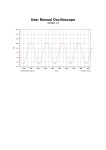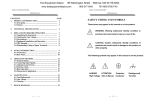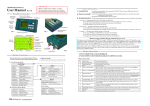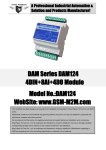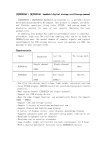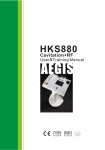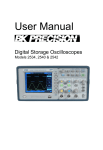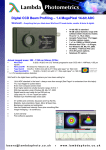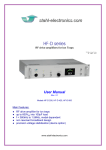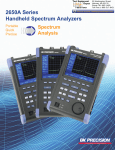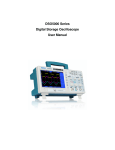Download USER`S MANUAL - CONRAD Produktinfo.
Transcript
CQ5010B SINGLE TRACE 10MHZ OSCILLOSCOPE USER’S MANUAL ⎯⎯⎯⎯⎯⎯⎯⎯⎯⎯⎯⎯⎯⎯⎯⎯⎯⎯⎯⎯⎯⎯⎯⎯⎯⎯⎯⎯⎯⎯⎯⎯⎯⎯ CONTENTS ⎯⎯⎯⎯⎯⎯⎯⎯⎯⎯⎯⎯⎯⎯⎯⎯⎯⎯⎯⎯⎯⎯⎯⎯⎯⎯⎯⎯⎯⎯⎯⎯⎯⎯ 1. SAFETY PRECAUTION 2. SPECIFICATIONS 2.1 VERTICAL SYSTEM 2.2 TRIGGER SYSTEM OS-10V 02/04/2001 Rev.2 2.3 HORIZONTAL SYSTEM 2.4 X-Y MODE 2.5 CALIBRATION 2.6 CRT 2.7 POWER SOURCE 2.8 PHYSICAL FEATURES 2.9 WORKING ENVIRONMENT 2.10 PRESSURE-PROOF TEST 3. CONTROL AND INDICATORS 3.1 CONTROL PANEL POSITION 3.2 FUNCTIONS OF CONTROL SWITCHES 3.3 OPERATING INSTRUCTION 4. MEASUREMENT 4.1 EXAMINATION AND ADJUSTMENT BEFORE TAKING MEASUREMENT 4.2 MEASUREMENT OF VOLTAGE 4.3 TIME MEASUREMENTS 4.4 PHASE DIFFERENCE MEASUREMENTS 4.5 X – Y MODE APPLICATIONS 5 . ACCESSORIES 1. SAFETY PRECAUTION CQ5010B is a portable Oscilloscope with frequency bandwidth of 0~10 MHz and sensitivity of 5mV/DIV~5V/DIV. Equipped with 10:1 probe which makes the sensitivity up to 50V/div. Sweep rate at 0.1S/DIV ~ 0.1µS/DIV on horizontal system. The oscilloscope is easy to operate, and highly reliable. It is an ideal instrument for research, production, education, and development in electronic device or circuitry. The instrument is designed and tested in accordance with EN publication 61010, CAT II, Pollution degree II and Overvoltage 600V. The instrument has been tested in accordance to the following EC Directives (EMC): a. EN50082 b. EN55011 c. EN61000-3-2 d. EN61000-3-3 The instrument complies with the requirements of the European Council Directive 89/336/EEC (EMC Directive) and 73/23/EEC (Low Voltage Directive). To ensure that the instrument is used safety, follow all safety and operating instructions in this manual. If the instrument is not used as described in this manual, the safety features might be impaired. WARNING 1 OS-10V 02/04/2001 Rev.2 Non compliance with the warnings and/or the instructions for use may damage the instrument and/or its components or injure the operator. Take extreme care for the following conditions when using the instrument : z For your own safety and that of the instrument, you must follow the procedures described in this instruction manual and especially read all the notes preceded by the symbol carefully. z Do not use this instrument in a location where there is explosive gas in the vicinity. The use of this instrument in a location where there is explosive gas could result in explosion. z If there is any smoke, abnormal odor, or abnormal sound coming display type this instrument, immediately switch off the power and disconnect the power cord. Continuous using of this instrument under these conditions could result in electrical shock or fire. After disconnecting the power cord, contact the service offices for repair. Repair by the user is dangerous and should be strictly avoided. z Take care not to allow water to get into this instrument or the wetting of the instrument. The use of this instrument in a wet state could result in electrical shock or fire. If water or other foreign matter has gotten into this instrument, first switch the power off, remove the power cord and call for repair. z Do not place this instrument on an unstable place such as on a shaky stand or on a slant. The dropping or turning over of this instrument could result in electrical shock, injury or fire. If this instrument has dropped or its cover has been damaged, switch the power off, remove the power cord and call for repair. z Do not allow any foreign matter such as metal or inflammable substance to get in from the air hole. The entrance of any foreign matter from the ventilation port, etc., could result in fire, electrical shock, or power failure. z Use this instrument with the rated AC power supply. Use of this instrument with a voltage other than specified could result in electrical shock, fire or power failure. The usable power voltage range is marked on the rear panel. z Do not remove either the cover or panel. z Take sufficient care when measuring high voltages. z Do not modify this instrument. z Avoid use of any damaged cable or adapter. 2. SPECIFICATIONS 2.1 VERTICAL SYSTEM Sensitivity Trimming Ratio Rise Time Bandwidth(-3dB) Input Impedance Max. Input Voltage 5mV/DIV. ~5V/DIV ±3% ≧2.5:1 ≦35ns DC:0~10MHz AC:10Hz~10MHz 1MΩ ±3%,30 pF ±5pF 400V pk 2.2 TRIGGER SYSTEM Trigger Sensitivity Ext. Trigger Input Impedance Ext. Trigger Max. Input Voltage Trigger Sources Trigger Mode Int 1 div., Ext 0.3V 1MΩ 30pF 400Vpk Int, Line, Ext Norm, AUTO, TV 2 OS-10V 02/04/2001 Rev.2 2.3 HORIZONTAL SYSTEM Sweep Time Trimming Ratio 0.1S / DIV ~0.1µS / DIV ±3% ≧2.5:1 2.4 X-Y MODE Sensitivity Bandwidth(-3dB) 0.2V/DIV~0.5V/DIV DC: 0~1MHz AC: 10Hz~1MHz 2.5 CALIBRATION SIGNAL Waveform Range Frequency Symmetric Square Wave 05.V ±2% 1kHz ±2% 2.6 CRT Display Area Accelerating Voltage Display Color 8 × 10DIV 1DIV=6mm 1200V Green 2.7 POWER SOURCE Voltage Range Frequency Power Consumption 110V ±10% 60Hz ±2Hz 25W 2.8 PHYSICAL FEATURES Weight Dimensions (H x W x D) 3kg 190 ×130 ×270mm 2.9 WORKING ENVIRONMENT Working temperature Storage Environment Working Altitude 5°C ~ 40°C -30°C ~60°C, 10~80%RH ≤2000m 2.10 PRESSURE-PROOF TEST Pressure-proof test 1500V 1min 3 OS-10V 02/04/2001 Rev.2 3. CONTROL AND INDICATORS 3.1 Control Panel Position 3.1.1 Front Panel Fig 3-1 POWER 1 ~ 10MHz HANDY OSCILLOSCOPE 2 INTENSITY 3 FOCUS 4 PROBE ADJUST 5 1kHz 0.5Vpp VOLTS/DIV. V 14 .5 .2 .1 50 mV 1 20 2 10 6 7 5 5 POSITION VOLT VAR. POSITION TIME VAR. 15 CAL CAL + _ 16 X EXT 8 LEVEL + _ AUTO NORM TV 10 11 Y INPUT DC AC INT. LINE EXT. 1M 30pF 18 9 1M 30pF 17 12 13 3.1.2 Rear Panel Fig 3-2 22 21 20 19 4 OS-10V 02/04/2001 Rev.2 3.2 FUNCTIONS OF CONTROL SWITCHES NO. 1 2 3 4 SWITCHES POWER SWITCH POWER LIGHT INTENSITY FOCUS 5 CALIBRATION 6 7 TIME/DIV Horizontal POSITION Time VAR 8 9 10 11 12 13 14 15 16 17 18 19 FUNCTIONS Power on/off. Lights when power on. Controls brightness of display. After obtaining appropriate brightness with INTENSITY, adjust FOCUS for clearest line. Provide symmetric square wave for 0.5V range, frequency=1KHz. Used for adjusting 10:1 Capacitor and adjusting the vertical & horizontal sensitivity. Selects the sweep rate . Horizontal positioning control of trace on the screen. Provides continuously variable sweep rate, turn clock wise to the end is the calibrating position. LEVEL Control signal trigger to sweep at certain level. +/- , +: Triggering occurs when trigger signal crosses trigger EXT/X level in a positive-going direction. -: Triggering occurs when trigger signal crosses trigger level in a negative-going direction. EXT/X: X-Y switch. AUTO/NORM/ AUTO : a single trace shown on screen even no signal. TV Automatically reverts to triggered sweep operation when adequate triggered signal is present. Needs to adjust the Level. NORM: No trace on screen if no signal. Trace is only generated when adequate trigger signal is present TV: used to show TV signals. INT/EXT/LINE Switch to select the Trigger Source INT/EXT/LINE. Ext. Trig Input When switching [10] to EXT/X, it’s X-Y input terminal; Terminal When switching [12] to EXT, it’s Ext. Trig. Input terminal. VOLTS/DIV Adjusting sensitivity of vertical system. Vertical POSITION Control vertical position of trace on the screen. Volt VAR Continuously adjusting the sensitivity of vertical system, turn clockwise to the end is the calibration position. coupling options Selects input coupling options. (AC⊥DC) INPUT Vertical input terminal. POWER INPUT power input connector (refer to the rear panel for voltage) CONNECTOR 220 V ±10%; fuse 2 x 0.5A (on rear panel). AND FUSE 3.3 OPERATING INSTRUCTION 5 OS-10V 02/04/2001 Rev.2 3.3.1 VOLTAGE CHECKING CQ5010B oscilloscope use 220V ±10% voltage. Before using, make sure that the correct voltage is being used. Otherwise, it would cause accident and damage to the instrument. 3.3.2 BASIC OPERATION (1) POSITION FOR CONTROL SWITCHES CONTROL SWITCHES POSITION INTENSITY [3] Center FOCUS [4] Center POSITION [7] [16] Center VOLTS/DIV [15] 0.1V VAR [8] [17] Calibration position AUTO/NORM [11] Auto TIME/DIV [6] 0.5mS SLOPE +/- [10] + INT/EXT/LINE [12] Int DC AC⊥DC [18] (2) OPERATION a. Power on [1], b. Power lights at [2], c. Allow for warm-up of about 5 minutes, then adjust the intensity[3], d. Adjust focus [4] for clearest line. If unstable, adjust level [9] . (3) Horizontal Level Adjustment : a. Slightly turn [20]、[22] counter clockwise, but not to unscrew; b. Insert a straight end screw driver to [21], and observe the wave, move screw driver in order to let the waveform parallel with the horizontal line ; c. Screw the [20] 、[22]. (4) Connects the calibration signal [5] to Y input terminal[19] with 1:1 probe (5) Adjust positions [7] 、[16] to obtain waveform like Fig 3-3. Fig 3-3 3.3.3 VERTICAL SYSTEM OPERATION (1) VOLTS/DIV switch should turn to correct position following the input signal range. Adjust position [14] to show the whole waveform within available area. Adjust with VAR [16] if necessarily, trimming ratio is ≧2.5:1. (2) Input coupling options: “DC"is used for observing object with direct current signal such as logical and static signals, “DC” must be used with low frequency. “AC"is used for observing the AC component of signals. “⊥"is used to establish a trace at the zero volt reference. 6 OS-10V 02/04/2001 Rev.2 (3) X-Y OPERATION: When [10] set at EXT/X, The oscilloscope is used for X-Y operation, at this moment Input [18] is Y-axis with the same sensitivity, Input [13] as X-axis, [14] can be adjusted continuously within 0.2V/DIV~0.5V/DIV. 3.3.4 TRIGGER SOURCE In Fig 3-1, [12] provides 3 sources for selection, INT trigger、EXT trigger input from [13], LINE input from power source. 3.3.5 HORIZONTAL SYSTEM OPERATION (1)Sweep setup : turn the sweep switch to correct position according to signal frequency, adjust POSITION [7] to show the whole waveform within available area. Adjust with VAR [8] if necessarily, trimming ratio is ≧2.5:1. (2)There are 3 kinds of Trigger sources: [11] “AUTO"auto sweep, when triggering signal is applied, Level [9] will adjust to proper position. The screen showing steady free run wave required frequency higher than 20Hz; [11] “NORM"while waiting for sweep, no trace; when receiving input signal, the circuits was triggered to sweep and show waveform . [11] “TV” used to determine TV signal. The signal is negative. (3)SLOPE selection: Used to select whether the trigger signal crosses trigger level in a positive-going or a negative-going direction. (4)Level setup : Use to adjust signal sweep on a level as starting reference. 3.3.6 SIGNAL CONNECT (1) Probe operating : Use 10:1 to 1:1 alternating probes. When using 10:1 probe, input impedance is 10MΩ 16 pF. While if 1:1 is used for observing lower signal, input impedance is 1MΩ 30 pF. At this stage, please consider of the affection of the probe upon the detected circuits. (2) Probe Adjustment Before using , 10:1 probe must be adjusted correctly, see Point 4.1.2 4 Measurement 4.1 EXAMINATION AND ADJUSTMENT BEFORE MEASUREMENT In order to be more accurate and prevent errors, the following observations should be done before taking measurement. 4.1.1 TRACE ROTATION Generally, horizontal trace on the screen should parallel with the horizontal line. Due to the earth’s magnetic field and other factors which causes horizontal trace leaning and making errors, you must examine the followings before taking measurement: (1) Adjust components on the front panel to obtain a horizontal trace on the screen . (2) Adjust vertical position and make sweep baseline lied in horizontal line of vertical center (3) Examine whether sweep baseline is parallel with horizontal line, if not , please following point 3.3.2(3) to correct it . 4.1.2 PROBE COMPENSATION Adjustment of probe is useful to compensate mistakes cause by difference of oscilloscope input characteristic: (1) Follow step 3.3.2, setup front panel components, and obtain a sweep baseline. (2) Set VOLTS/DIV to 10mV/DIV. 7 OS-10V 02/04/2001 Rev.2 (3) Connect CH1 10:1 probe to input terminal, and connect with “CAL”. (4) Follow Chapter 3 to operate relative components, get waveform on the screen as figure 4.1 (5) Observe whether the waveform compensation is good, if not , you can adjust the LF compensation components as shown in figure 4-2 Good Compensate Over Compensate Fig 4-1 Under Compensate LF COMP Fig 4-2 4.2 MEASUREMENT 4.2.1 P-P Voltage Measurements Step : (1) Input signal to INPUT [18] terminal. (2) Setup VOLTS/DIV and observe waveform, let waveform display on the screen within 5 divisions, and turn VAR clockwise to the calibration position. (3) Adjust level to make waveform steady. (4) Adjust sweep controls to show at least one cycle waveform on the screen. (5) Adjust vertical position to make the bottom of waveform lies on a horizontal axis on the screen. Fig 4-3A. (6) Adjust horizontal position to make the top of waveform lies center of vertical axis. Fig 4-3B. (7) Read the divisions between A-B on vertical direction. (8) Calculate the signal Vp-p using the formula below : Vp-p= DIV of vertical direction× Sensitivity For example, In Fig 4-3, vertical divisions of A-B is 4.1 DIV, sensitivity of the 10:1 8 OS-10V 02/04/2001 Rev.2 probe is 2V/DIV, then Vp-p=2×4.1=8.2(V) B A Fig 4-3 4.2.2 DC VOLTAGE MEASUREMENT STEP: (1) Setup front panel connector to obtain a sweep baseline on the screen. (2) Setup input coupling options as “⊥”. (3) Setup POSITION, let sweep baseline coincide with horizontal center, define it as zero reference level. (4) Input signal into terminal. (5) Set input coupling to “DC”, adjust VOLTS/DIV, let waveform show in the proper position on the screen, turn VAR to the calibration position. (6) Read the divisions between the zero reference level to the wave form by the tested object. (7) Calculate the DC voltage: V= divisions on vertical axis × sensitivity × direction(+/-) Shown in Figure 4-4, zero reference level at the center, use 10:1probe, sensitivity is 2V/Div, 2 points as A & B, A is 1.5 Div. over the zero reference level, B is 3Div. below the zero reference level. DC voltage level of the 2 points are : VA = 1.5 x 2 x (+) = 3 V VB = 3 x 2 x (-) = -6 V Fig 4-4 Level A Zero-volt Reference B Level 9 OS-10V 02/04/2001 Rev.2 4.3 TIME MEASUREMENTS 4.3.1 TIME SPACE MEASUREMENTS This is a procedure for making time (period) measurements between two points on a waveform: (1) Connect the signal to be measured to the input terminal [18]. (2) Adjust level to obtain steady waveform. (3) Turn VAR clockwise to the calibration position, and set sweep controls to obtain a normal display of 1-2 signal cycles. (4) Using the vertical and horizontal positions, set two points to be measured in the waveform on the same horizontal level. (5) Measure the distance between the two points , the measurement is calculated by the following equation: Distance between 2 points (DIV) × rate of sweep (t/Div) TIME (S) = -------------------------------------------------------------------Horizontal factor Shown in figure 4-6, distance between A & B is 8 Div. sensitivity is 2 µS/Div, Horizontal factor x 1, then Time measurement is 16µS Fig 4-6 A B 4.3.2 CYCLE & FREQUENCY MEASUREMENTS Shown in Fig 4-6, frequency measurements are made by measuring the time period of one cycle of waveform (T), and calculating the frequency that equals the reciprocal of the time period. For example, T=16µS, then frequency is: 1 F =1/T = ------------------ = 62.5 KHz 16 ×10-6 4.3.3 PULSE RISE TIME AND FALL TIME MEASUREMENTS 10 OS-10V 02/04/2001 Rev.2 For rise time and fall time measurements, the 10% and 90% amplitude points are used as starting and ending reference points. (1) Apply a signal to the input jack [18]. (2) Use the VOLTS/DIV and VAR controls to adjust the waveform peak to peak height to five divisions. (3) Adjust vertical position so that the tops of the waveform coincide with 100% point, while the bottoms of the waveform coincide with 0% point. (4) Adjust Sweep switch to obtain the positive-going direction or negative-going direction of the waveform on the screen. (5) Use the horizontal POSITION control to adjust the 10% points to coincide with a vertical reference line. (6) Measure the horizontal distance in divisions between the 10% and 90% points on the waveform (divisions). (7) Pulse rise time and fall time measurement is calculated by the following equation: Horizontal distance (div) × sensitivity (Time/div) Rise Time = ----------------------------------------------------------Horizontal factor For the example shown in Fig.4-7, the horizontal distance from 10% to 90% is 2.4 divisions, the sweep TIME/DIV setting is 1µS/DIV, factor x 1. The rise time is calculated as follows: 1µS/DIV × 2.4DIV Rise Time = ------------------------------ = 2.4µS 1 Fig. 4-7 100% 90% 10% 2.4DIN 4.4 TV Signals measurement Steps : (1) Connect TV signals to INPUT jack [19] (2) Set Trigger method to “TV” [10], Sweep switch turn to 2mS/Div. (3) Observe the screen, it should be negative synchronize pulse wave. (4) Adjust VOLTS/DIV and VAR to obtain proper range. 4.5 X– Y mode applications 11 OS-10V 02/04/2001 Rev.2 There are some cases which X axis requires control from external signals, e.g. external connection of sweep signals, signals of Lissajous pattern or other equipment’s display setup. X-Y mode operation is turn [10] to EXT/X, input signals through [13], sensitivity to be adjusted directly with [14], then input Y signal through [18]. 5 . ACCESSORIES 1 2 3 Probe 1 pc. Cord 1 pc. User’s manual WARNING DO NOT OPEN THE CASE, HIGH VOLTAGE EXISTED. 12













